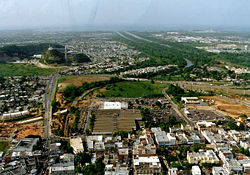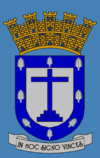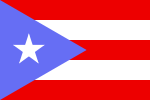Bayamón, Puerto Rico
| Bayamón, Puerto Rico | |||
 |
|||
|
|||
| Nickname(s): "La ciudad del Chicharrón & Science Town" | |||
 |
|||
| Coordinates: | |||
| Country | United States | ||
|---|---|---|---|
| Territory | Puerto Rico | ||
| Founded | May 22, 1772 | ||
| Government | |||
| - Mayor | Ramón Luis Rivera, Jr. (New Progressive Party of Puerto Rico) | ||
| - Senatorial dist. | 2 - Bayamón | ||
| - Representative dist. | 7, 8, 9 | ||
| Area | |||
| - Total | 44.5 sq mi (115.34 km²) | ||
| - Land | 44.4 sq mi (114.95 km²) | ||
| - Water | 0.2 sq mi (0.39 km²) | ||
| Population (2000) | |||
| - Total | 224,044 | ||
| - Density | 5,048/sq mi (1,949.06/km²) | ||
| Time zone | AST (UTC-4) | ||
| Gentilic | Bayamoneses | ||
| Anthem - "Bayamón, ciudad hermosa" | |||
| Website: http://www.municipiodebayamon.com | |||
Bayamón is a municipality of Puerto Rico located on the northern coastal valley, north of Aguas Buenas and Comerío; south of Toa Baja and Cataño; west of Guaynabo; and east of Toa Alta and Naranjito. Bayamón is spread over 11 wards and Bayamón Pueblo (The downtown area and the administrative center of the city). It is part of the San Juan-Caguas-Guaynabo Metropolitan Statistical Area.
Contents |
History
Bayamón is sometimes called "El Pueblo del Chicharrón" (Pork Rind Town). Juan Ramírez de Arrellano established Bayamón as a town on May 22, 1772. It derives its name from a local Indian chief Bahamon; others claim that the name came from the Taíno word Bayamongo, which is the name of one of the rivers that crosses the city.
Bayamón is one of Puerto Rico's largest cities, and is situated in what is considered to be the island's metropolitan area. It shares its metropolitan area status with San Juan, Guaynabo, Cataño, Toa Baja, Carolina and Trujillo Alto
Bayamón has always been a progressive city. Unlike Ponce, Aguadilla and Mayagüez, it does not have an airport due to its proximity to San Juan, the American territory capital.
Flag
The current flag of Bayamón, with a white field, official color of Bayamón, was embroidered by Mrs. Gloria M. León and maintains the design and colors of its Coat of Arms.
Coat of arms
This shield is symbol and synthesis of the history and the values that distinguish the city of Bayamón. The main colors of the shield are blue and silver representing the waters of the Bayamón river and recalls that it was on these banks where the first hydraulic sugar cane refinery of Puerto Rico was established in 1549. The center contains the Holy Cross (Santa Cruz), patron of the first church of the municipality and the name of the old sugar cane refinery "Santa Cruz", which was the historical origin of the town of Bayamón. The sugar cane flowers (guajanas) allude directly to the sugar cane industry that is of social and economic importance to the origin and development of Bayamón.
The five-tower crown, which is used for cities, was assigned to Bayamón as an exception for its extraordinary urban development, the magnitude of its population and for its religious dignity, which will possibly be raised to become Episcopal seat. The motto "IN HOC SIGNO VINCES" makes reference to Emperor Constantine when in the IV century had the vision in which the victory was promised to him if it accepted the Cross of Christianity as his banner.
Demographics
Barrios (Districts/Wards)[1]
| Districts | Population |
| Pueblo de Bayamón | 5,336 |
| Buena Vista | 15,878 |
| Cerro Gordo | 34,161 |
| Dajaos | 2,691 |
| Guaraguao Abajo | 8,494 |
| Guaraguao Arriba | 1,681 |
| Hato Tejas | 46,528 |
| Juan Sánchez | 25,747 |
| Minillas | 42,617 |
| Nuevo | 2,394 |
| Pájaros | 32,855 |
| Santa Olaya | 5,662 |
| Total | 224,044 |
Geo/Topography
Bayamón rivers include: Bayamón, Hondo, Minillas, Bucarabones and Cuesta Arriba.
Anthem
Music By: Rafi Escudero
Bayamón, ciudad hermosa
orgullosa de su ayer
al mirar hacia el futuro
ves un nuevo amanecer.
En tu gente la esperanza
son tus hijos tu primor
porque luchan sin descanso
por triunfar y darte honor.
Bayamón, mi ciudad
mi lugar es aquí
porque quiero luchar
en tu suelo hasta morir.
Bayamón, mi ciudad
orgulloso estoy de ti
de tu amor cantaré,
en un himno al porvenir.
Bayamón, mi ciudad
mi lugar es aquí
porque quiero luchar
Economy
Agriculture
Coffee, grapefruit, sugar, tobacco and vegetables. The first hydraulic sugar mill on the island was built in Bayamón about 1548, and sugar has continued to be a valuable commodity.
Business
Commercial offices, Hospitals and Commercial centers are available throughout the city. Bayamón is one of the Puerto Rican cities with most shopping centers per capita. Here are some:
- Plaza Del Sol Mall
- Plaza Río Hondo Mall
- Cantón Mall
- Plazoleta del Cantón
- Drive-in Plaza Shopping Center
- Bayamón Oeste Shopping Center
- Rexville Towne Center
- Rexville Shopping Center
- Bayamón Shopping Center
- Bayamón Norte Shopping Center
- Plaza di-Luna
- Santa Rosa Mall
- Plaza Del Parque Shopping Center
- Plaza Tropical Shopping Center
Industry
Factories: auto parts, canned foods, clocks, clothing, machinery, tin cans, tobacco products, tools, watches, zippers, iron foundries, brick yards, ice plants, dairies, and an oil refinery. The city has many industrial parks like Luchetti Industrial Park.
Among companies with established factories in the city we can mention: Caribbean Petroleum (Gulf), Goya and ,Coca-Cola Puerto Rico.
Tourism
Landmarks and places of interest


- Bayamón Central Park
- Braulio CastilloTheater
- Francisco Oller Museum
- José Celso Barbosa Monument
- Juan Ramón Loubriel Stadium
- Rubén Rodríguez Stadium
- El parque del tren, a park featuring what was until 2001 Puerto Rico's only working train, and an example of a DC-3 that used to fly for United Airlines. (This park, however, was destroyed due to major road construction which is still underway.) What is left of it is now a small plaza for activities and an area for jogging and passive entertainment.
- A suspension bridge is a pedestrian only bridge, believed to be one of only 3 of its kind in all of Puerto Rico.
- A science-themed park known as Parque De Las Ciencias. It is the only place, outside of the United States, where you can find an exhibition of NASA rockets and rockets parts. It is located in the middle of carcic hills. From an oberservation building on one of the hills is a stuning view of the metropolitan area. The building also hosts antennas for governmental and civil communication.
- City Hall- This building crosses over a major road. While walking through a connecting corridor, right above the road, pedestrians can see passing cars underneath. It is believed to be the only building of its class in the world.
- Bayamón is also one of the cities to host the Tren Urbano (Urban Transit System commuter train), inaugurated in 2004.
Festivals and events
- Santa Cruz Patron Festivities - May
- José Celso Barbosa's Birthday - July
- Chicharrón Festival - July
- Artesans Festival - July
Education
Bayamón has many public and private schools. It also has many higher-learning institutions such as the University of Puerto Rico at Bayamon, the Inter-American University of Puerto Rico, Bayamon Central University, American University, Universidad Central del Caribe, and some community colleges.
Sports
The Vaqueros de Bayamón are the city's BSN representatives and the team with the most championships in history, with 13.
The famous boxing fight between Alexis Arguello and Alfredo Escalera (their first; their equally legendary rematch was held in Rimini, Italy) was held in Bayamón in 1978.
The Puerto Rico Islanders of the United Soccer Leagues First Division play at Juan Ramon Loubriel Stadium in Bayamón. A new team Sevilla FC are to start playing out of the stadium in the Puerto Rico Soccer League in 2008.
Notable "Bayamoneses"
- Chuito el de Bayamón (1900 - 1979), folk singer/musician
- Braulio Castillo Cintrón (b. 1933), actor
- Daniel Santos - world boxing champion
- Felipe Lopez, baseball player
- Francisco Oller - painter
- Gilbert Cosme (b. 1976), professional wrestler better known by his ring name, Ricky Banderas, Judas Mesias and "El Mesias"
- Hector 'Macho' Camacho world boxing champion
- Dr. José Celso Barbosa, physician, journalist, politician & poet
- Jose Molina (major league baseball catchers)
- Lucecita Benítez, singer
- Christopher Gomez (1978-)
- Molina Brothers; Yadier Molina, Bengie Molina, and
- Omar Rodriguez-Lopez, musician
- Pedro Ortiz Dávila (Davilita), singer
- Santiago Polanco Abreu, politician, legislator
- Sonia Noemí González (b. 1941), actress/singer
- Wilfredo Vazquez - World boxing Champion raised Barbosa Public Housing
Diplomacy
Bayamón serves as the host city for foreign consular representation in Puerto Rico for the following nations:
See also
- Puerto Rico Islanders USL soccer
References
External links
- Bayamón and its barrios, United States Census Bureau
- City of Bayamón
- Bayamón site on Puerto Rico portal
Colleges / Schools / Universities
- American University of Puerto Rico
- Bayamón Central University
- Caribbean University
- Inter-American University of Puerto Rico - Bayamón Campus
- Universidad Central del Caribe
- University of Puerto Rico in Bayamón
|


